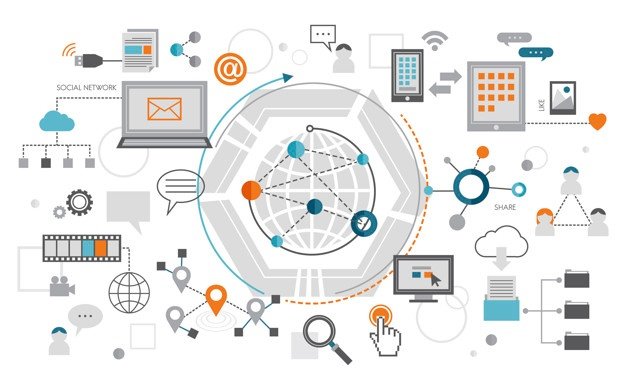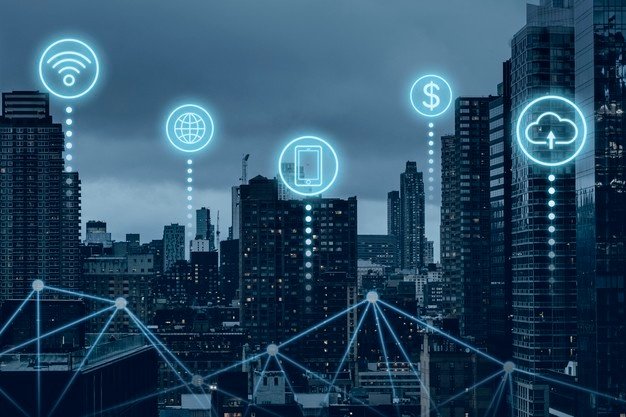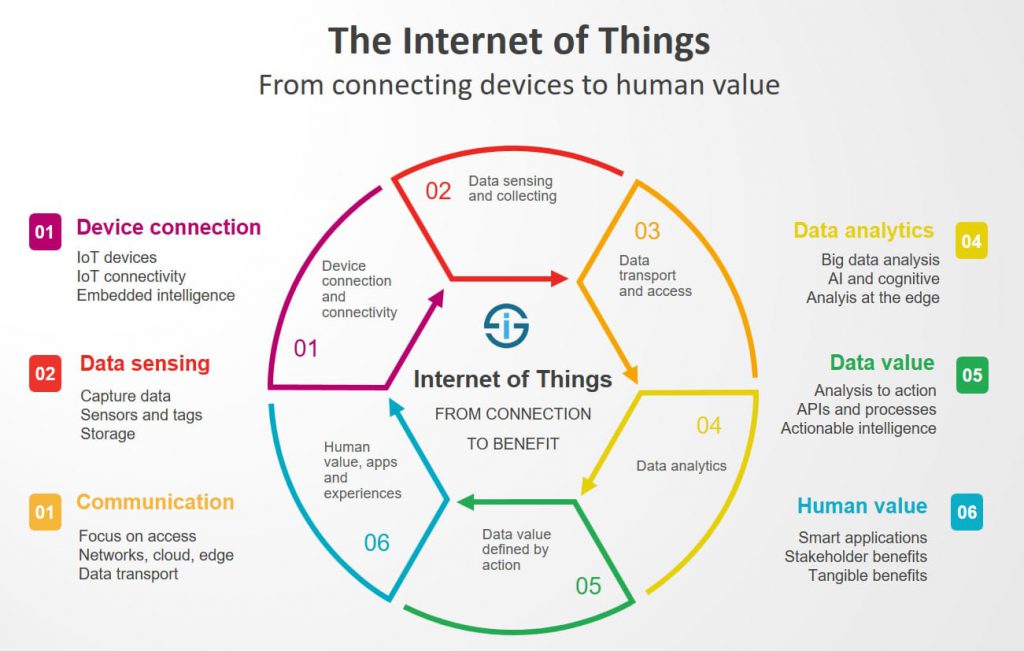The Internet of Things is one of the latest inventions that is currently being developed because it has advantages in terms of functionality and supports performance without the use of cables, and is based on wireless. Technology is a breakthrough that humans have created for several generations. So, every time experiencing many changes and the discovery of new things. At that time, wireless-based network access and resources also developed and replaced the current use of wired networks.
Would you happen to be familiar with innovative home technology? This technology allows you to control various devices in your home via a smartphone.
Thanks to the Internet of Things (IoT), you can enjoy all these conveniences. IoT connects various devices through the internet. That way, you can control it anywhere and anytime to make your daily life easier.
In addition to making everyday life easier, IoT can also be used to collect data. The goal is to facilitate decision-making in business activities.
This article will discuss everything about the Internet of Things, its constituent elements, how it works, and examples of its application. So, in the future, you will better understand the concept and use of the Internet of Things in everyday life.
What is the Internet of Things?

Internet of Things is a concept or program where an object can transmit or transmit data over a network without computers and humans’ help. The Internet of Things, often called IoT, is experiencing many developments.
The development of IoT can be seen from the level of convergence of wireless technology, microelectromechanical (MEMS), internet, and QR ( Quick Responses ) Code. IoT is also often identified with RFID ( Radio Frequency Identification ) as a method of communication.
In addition, it also includes sensor-based technologies, such as wireless technology and QR codes, which we often encounter. The ability of the IoT itself is unquestionable. So many technologies have implemented IoT systems, such as light sensors and sound sensors from the latest Google technology, namely Google Ai and Amazon Alexa.
And most recently, Smart City has been implemented in several developed countries, such as China and Germany. Thus, all forms of activity of residents of a city can be adequately monitored by a system with a large-scale database network.
The data transfer process in IoT is carried out with various technologies—for example, sensors, QR codes, to Radio Frequency Identification (RFID) on a device.
IoT can make everyday life easier by connecting various technologies using an internet connection. This is because connected devices can automatically collect and analyze data to perform your orders.
One example of IoT in everyday life is an intelligent home system, which automates the operation of a house or building.
In addition, you can also find it in business activities. For example, the QR Code in the payment method and the barcode scan method to determine the product’s price.
Then, IoT can also be used to collect various data in business processes. For example, data on customer activity, machine performance, and product stock movements.
The data will be processed into insights that help make business decisions, such as developing features that support user experience and findings in new product innovations.
How the Internet of Things (IoT) Works
The way the Internet of Things works is to use an argument from a programming language algorithm that has been compiled. Each statement formed will result in an interaction to help the hardware or machine perform a function or work.

Thus, the machine no longer requires human assistance and can be controlled automatically. The most critical factor in the program’s running lies in the internet network, which links the system and hardware. The main task of humans is to be a supervisor to monitor every action and behavior of the machine while working.
The biggest obstacle to the development of the Internet of Things is in terms of resources which are quite expensive, as well as the arrangement of a very complex network. Development costs are also too expensive; not all cities or countries have used IoT as their primary need.
Benefits of the Internet of Things in Business
The following are the benefits of the Internet of Things for business:
1. Cut Operational Costs
IoT connects various device data in one interface. You include it in your smartphone interface. So, you can monitor data and access devices from anywhere.
Thanks to these conveniences, you can cut operating costs. The simplest example, you get a notification that your AC power usage data exceeds capacity. So, you can immediately turn off the AC from your smartphone.
That way, you can turn off the device before it wastes electricity. Your operational costs can also be more efficient.
2. Improve Work Efficiency
One of the benefits of IoT is the automation of devices—for example, soil sprinklers or automatic fertilizer givers. With automation, business or farm owners can increase work efficiency. This is because automated machines have done time-consuming, repetitive work. So employees can move on to other, more critical jobs.
3. Providing Insight Data for Business Decision Making
With the help of Artificial Intelligence, IoT will process customer data into valuable insights for business decisions. Could you give me some examples?
First, you can promote your product to specific customers. The incoming data from the QR Code will be processed into product purchase pattern data from customers aged 20 to 35 years. Using this data, you can determine which customers’ favorite products can be re-promoted later.
Second, you can discover what product features you need to improve or remove. This is because complaints that come in via the chatbot website will be processed into data for consideration.
4. Improve Customer Experience
Another benefit of IoT is that it improves the customer experience. Because IoT can speed up the customer service process. An example is the use of chatbots. The chatbot will automatically answer customer complaints with solutions. So customers can get solutions faster without waiting—the way a chatbot works can make 34% of customers more comfortable than customer service staff. The reason is that they can receive answers faster.
Elements of the Internet of Things

Earlier, you happened to know how IoT works and its benefits. In that workflow, several elements play a role in IoT. The following are the elements of IoT or IoT level:
1. Sensor
The first element of IoT is sensors. Sensors are devices that function to record and collect data. Usually, the sensor is a microchip installed in an IoT device—for example, barcode scanning tools, cameras, and smartphone GPS.
2. Connectivity
After the data is recorded, it must be sent to the data processing site. Therefore, data needs connectivity. Connectivity is an Internet of Things element that connects a component to another in the IoT ecosystem, for example, between sensors, devices, and data stores.
Well, these elements are connected with various types of internet networks. Examples are WiFi, Bluetooth, and satellite. Each type of internet network has a different power consumption level, range, and capacity. However, all of them have the same goal. That is, sending the data obtained to the storage (cloud).
3. Cloud
Thanks to connectivity, your data can be sent to the cloud. Cloud is a server for storing and processing data according to the needs of IoT users.
For example, a product barcode a sensor records is processed into a product price that appears on a computer screen. In addition, purchase history data from the QR Code can be processed into customer preference data.
4. Artificial Intelligence
Artificial Intelligence (AI) is an invention that can provide the ability for any technology or machine to think (to be “smart”). So, AI here is done by collecting data, installing networks, and developing algorithms from artificial intelligence.
So, from the beginning, a machine can only carry out commands from the user directly; now, it can carry out various activities independently without waiting for instructions from the user. For example, AI technology is applied to robot servers at a restaurant in Japan.
Where the robot’s ability to think like an honest human servant. Because in the control system, the robot has used the help of AI. By covering various sources of data and information entirely and complex algorithms.
5. User Interface
The last element is the user interface. The user interface serves to display information that has been processed by the cloud to IoT users.
For example, a display on a smartphone that presents data on air conditioning temperatures in your office or home. When the power usage exceeds the reasonable limit, you will receive a notification on your smartphone.
Example of Internet of Things

There are so many examples of the application of IoT in everyday life that you are very close to without realizing it. The following are examples of fields implementing Internet of Things technology.
1. Health sector
The first example of the Internet of Things is the health sector. Currently, there are lots of advanced technologies that can help the performance of doctors and medical personnel. IoT also makes a breakthrough in the development of medical machines and devices to support the implementation of medical personnel to be more effective and precise and reduce the risk of errors.
One example of IoT in the world of health is helping to record heart rate data, measure body sugar levels, check body temperature, and so on. The data obtained will be stored in large-scale data storage.
Currently better known as big data. By using big data, you can read information and data in the form of numbers or text quickly and efficiently. Medical personnel no longer need to record manually because all information can be stored in a database and will be sent to the IoT machine to perform tasks according to the developed algorithm.
2. Energy field
In the energy sector, various problems arise. Starting from pollution or pollution, waste, and reduced supply of resources. Therefore, the existence of IoT itself can reduce some of these risks. For example, applying a light sensor can reduce the use of electrical energy.
This sensor can capture light particles, so when there is a lot of light, the lights will turn off. However, the light will automatically turn on when there is no light supply.
Then, it can also apply to the scheduling function carried out on the oven machine, the heating machine integrated with the internet network. And a concrete example we often encounter is on smart TVs that have implemented IoT for channel search methods tailored to the user’s choice ( user ).
3. Transportation
Intelligent technology has also reached the field of public transportation. Usually, you always drive a car yourself according to the rules and driving skills you have learned. However, did you know there is a new invention where you can run a car without driving yourself?
The car can run itself according to procedures and is appropriately programmed. So, you can feel the sensation of the autopilot system on an airplane. The vehicle development stage is still being piloted in several developed countries.
Besides vehicles, traffic systems are also included in the scope of the Internet of Things. With the Internet of Things (IoT), you can control various traffic systems when conditions are jammed or quiet. Thus, it can reduce the risk of accidents and traffic violations.
4. General environment
The last example of the Internet of Things is in the field of the general environment. All human, plant, and animal activities can be monitored using IoT technology. For example, researching water quality requires an accurate and reliable source of information.
With the help of the Internet of Things, you can search for valid and fast data sources. Not only that, but the geographical area presented is also quite broad and can reach more areas. With the help of big data, problems regarding data transfer speed and data reading are well covered.
5. Agriculture
There are various applications of IoT in agriculture. One example is the technology of detecting rainfall and the state of agricultural land. Both of these tools will collect and process data. For example, data fluctuations in soil temperature and humidity. So, the data will be used for decision-making by farmers. For example, they are fertilizing and applying more precise pesticides.
6. Business Field
An example of the application of IoT in the business field is the automation process in business services. The goal is to make it easier for customers to buy products. The following are examples of IoT that you can find in the business field:
- QR Code Payment
QR Code payment is an IoT that you often encounter nowadays. Especially when you pay for a product. For example, you visit a website to buy a product. The website has a QR Code for product payments. You will be asked to enter the payment amount when you scan the QR Code with your smartphone camera. After making a payment, your data will be recorded and stored in the website database. This process will produce various customer data that IoT processes into multiple specific data types—for example, the trend of product purchases.
- Website Chatbot
Another example of IoT is chatbots. Chatbots are commonly used in 24-hour Customer Service on a website. A chatbot is a computer program that mimics human interactions in chat. The difference is this chatbot is connected to IoT machine learning. Its function is to receive data and respond to that data automatically based on data analysis.
For example, some customers complain about a product to the chatbot of an online store website. In a short time, chat customers immediately get a reply in the form of a solution to their problem.
- Barcode
Barcode is an example of IoT in everyday life. Barcodes are usually used to store and display information related to specific products—for example, product stock quantity, price, and process details in the factory. Say you have a product in stock. You put a barcode on each product. When the sensor scans the barcode, you will see detailed information about the product.
Well, those were various examples of IoT in everyday life based on several industries. IoT has many benefits for everyday life and business, you know. Could you read on for the following discussion?
Benefits of the internet of things
After knowing in detail about the example of the Internet of Things, the next step is to discuss the benefits of the Internet of Things. The benefits here can be divided into three parts.

Could you simplify the connectivity process?
The first benefit of the Internet of Things is that it makes connecting between devices or machines easier. The better the connection between the networks, the more the device system can run faster and flexibly.
Many of you may still use conventional tools, but the answer is innovative technology if you are trying to operate the system centrally only through mobile devices.
Achievement of efficiency
The second benefit of the Internet of Things is the achievement of work efficiency. The more network connectivity that builds up, the less time it takes to perform a task will decrease. Thus, human activity and performance will be more assisted by IoT.
Increase the effectiveness of monitoring activities.
By using the Internet of Things, the effectiveness of controlling and monitoring a job becomes more accessible. In addition, intelligent technology can provide users with more effortless recommendations or work alternatives.
Conclusion
- Internet of Things is a concept where objects can transmit data using a network to perform work activities without the assistance of humans or interaction with computer devices.
- The IoT elements consist of several parts, such as connectivity, Artificial Intelligence (AI), small system devices, sensors, and active engagement. The IoT works by making programming algorithm arguments to generate program interactions with the internet network as a link between the two things.
- Examples of the application of IoT can be done in various fields such as health, transportation, environment, energy, and so on. The main benefits of the Internet of Things are efficiency, effectiveness, and connectivity.

